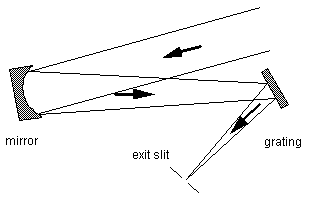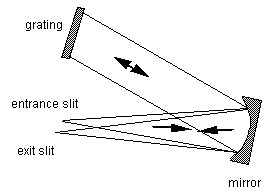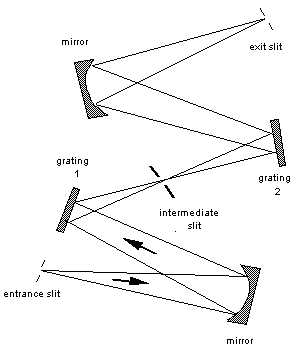| 6. | PLANE GRATINGS AND THEIR MOUNTS |
| PREVIOUS
CHAPTER NEXT CHAPTER |
Copyright 2000,
Richardson Grating Laboratory, All Rights Reserved |
| TABLE OF CONTENTS | |
| 6.1. GRATING MOUNT TERMINOLOGY |
| 6.2. PLANE GRATING MOUNTS |
| 6.2.1. The Czerny-Turner Monochromator |
| 6.2.2. The Ebert-Fastie Monochromator |
| 6.2.3. The Monk-Gillieson Monochromator |
| 6.2.4. The Littrow Mount |
| 6.2.5. Double Monochromators |
| 6.2.6. Triple Monochromators |
6.1 GRATING MOUNT TERMINOLOGY [top]
The auxiliary collimating and focusing optics that modify the wavefronts incident on and diffracted by a grating, as well as the angular configuration in which it is used, is called its mount. Grating mounts are a class of spectrometer, a term which usually refers to any spectroscopic instrument, regardless of whether it scans wavelengths individually or entire spectra simultaneously, or whether it employs a prism or grating. For this discussion we consider grating spectrometers only.
A monochromator is a spectrometer that images a single wavelength or wavelength band at a time onto an exit slit; the spectrum is scanned by the relative motion of the entrance (and/or exit) optics (usually slits) with respect to the grating. A spectrograph is a spectrometer that images a range of wavelengths simultaneously, either onto photographic film or a series of detector elements, or through several exit slits (sometimes called a polychromator). The defining characteristic of a spectrograph is that an entire section of the spectrum is recorded at once.
6.2 PLANE GRATING MOUNTS [top]
A plane grating is one whose surface is flat. Plane gratings are normally used in collimated incident light, which is dispersed by wavelength but do not focused. These mounts require auxiliary optics, such as lenses or mirrors, to collect and focus the energy. Some simplified plane grating mounts illuminate the grating with converging light, though the focal properties of the system will then depend on wavelength. For simplicity, only plane reflection grating mounts are discussed below, though each mount may have a transmission grating analogue.
6.2.1 The Czerny-Turner Monochromator
This design involves a classical plane grating illuminated by collimated light. The incident light is usually diverging from a source or slit, and collimated by a concave mirror (the collimator), and the diffracted light is focused by a second concave mirror (the camera); see Figure 6-1. Ideally, since the grating is planar and classical, and used in collimated incident light, no aberrations should be introduced into the diffracted wavefronts. In practice, aberrations are contributed by the off-axis use of the concave spherical mirrors.
Like all monochromator mounts, the wavelengths are imaged individually. The spectrum is scanned by rotating the grating; this moves the grating normal relative to the incident and diffracted beams, which (by Eq. (2-1)) changes the wavelength diffracted toward the camera. For a Czerny-Turner monochromator, light incident and diffracted by the grating is collimated, so the spectrum remains at focus at the exit slit for each wavelength, since only the grating can introduce wavelength-dependent focusing properties.
Aberrations caused by the auxiliary mirrors include astigmatism and spherical aberration (each of which is contributed additively by the mirrors); as with all concave mirror geometries, astigmatism increases as the angle of reflection increases. Coma, though generally present, can be eliminated at one wavelength through proper choice of the angles of reflection at the mirrors; due to the anamorphic (wavelength-dependent) tangential magnification of the grating, the images of the other wavelengths experience subsidiary coma (which becomes troublesome only in special systems).

Figure 6-1. The Czerny-Turner mount. The plane grating provides dispersion and the concave mirrors provide focusing.
6.2.2 The Ebert-Fastie Monochromator
This design is a special case of a Czerny-Turner mount in which a single relatively large concave mirror serves as both the collimator and the camera (Fig. 6-2). Its use is limited, since stray light and aberrations are difficult to control.

Figure 6-2. The Ebert-Fastie mount. A single concave mirror replaces the two concave mirrors found in Czerny-Turner mounts.
6.2.3 The Monk-Gillieson Monochromator
In this mount (see Figure 6-3), a plane grating is illuminated by converging light (r <0). Usually light diverging from an entrance slit (or fiber) is rendered converging by off-axis reflection from a concave mirror (which introduces aberrations, so the light incident on the grating is not composed of perfectly spherical converging wavefronts). The grating diffracts the light, which converges toward the exit slit; the spectrum is scanned by rotating the grating to bring different wavelengths into focus at or near the exit slit. Often the angles of reflection (from the primary mirror), incidence and diffraction are small (measured from the appropriate surface normals), which keeps aberrations (especially off-axis astigmatism) to a minimum.
Since the incident light is not collimated, the grating introduces wavelength-dependent aberrations into the diffracted wavefronts (see Chapter 7). Consequently the spectrum cannot remain in focus at a fixed exit slit when the grating is rotated (unless this rotation is about an axis displaced from the central groove of the grating, as pointed out by Schroeder5). For low-resolution applications, the Monk-Gillieson mount enjoys a certain amount of popularity, since it represents the simplest and least expensive spectrometric system imaginable.

Figure 6-3. The Monk-Gillieson mount. A plane grating is used in converging light.
6.2.4 The Littrow Mount
A grating used in the Littrow or autocollimating configuration diffracts light of wavelength l back along the incident light direction (Fig. 6-4). In a Littrow monochromator, the spectrum is scanned by rotating the grating; this reorients the grating normal, so the angles of incidence a and diffraction b change (even though a = b for all l). The same auxiliary optics can be used as both collimator and camera, since the diffracted rays retrace the incident rays. Usually the entrance slit and exit slit (or image plane) will be offset slightly along the direction parallel to the grooves so that they do not coincide; of course, this will generally introduce out-of-plane aberrations. As a result, true Littrow monochromators are quite popular in laser tuning applications (see Chapter 12).
6.2.5 Double Monochromators
Two monochromator mounts used in series form a double monochromator. The exit slit of the first monochromator usually serves as the entrance slit for the second monochromator (see Figure 6-5). Stray light in a double monochromator is much lower than in a single monochromator: it is the product of ratios of stray light intensity to parent line intensity for each system. Also, the reciprocal linear dispersion of the entire system is the sum of the reciprocal linear dispersions of each monochromator.

Figure 6-4. The Littrow monochromator mount. The entrance and exit slits are slightly above and below the dispersion plane, respectively; they are shown separated for clarity.
6.2.6 Triple Monochromators

Figure 6-5. A double monochromator mount.
| PREVIOUS CHAPTER NEXT CHAPTER |
Back to top